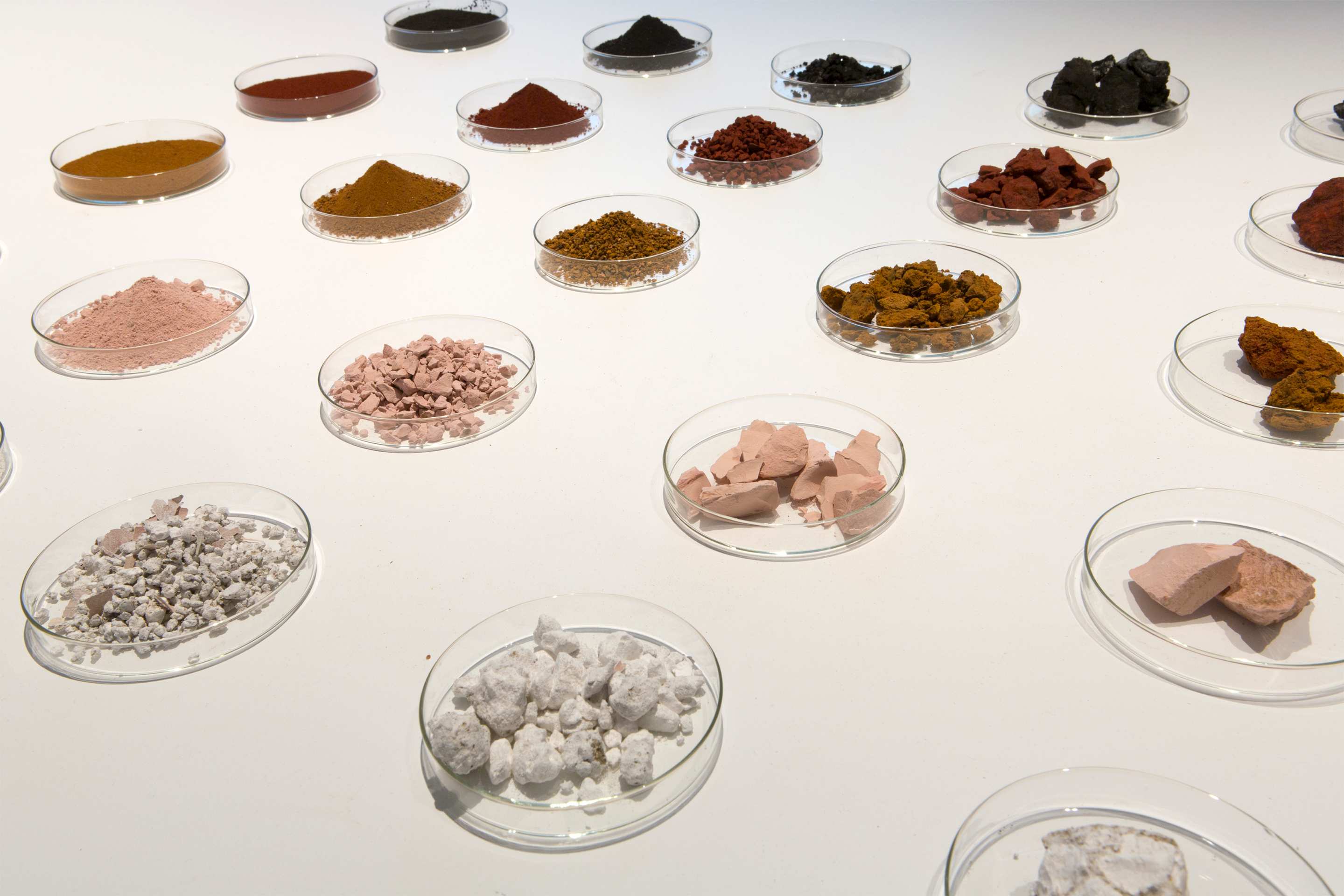Ochre, Spinifex & Foil unlocks new science and industry potential
In a stunning new exhibition at the University of Sydney's Tin Sheds Gallery, Ochre, Spinifex & Foil (OSF) investigates three materials embedded in Aboriginal and Torres Strait Islander history and culture, and unlocks their science and creative potential in art, architecture and manufacturing.

Warmun ochres in Ochre Spinifex & Foil at the University of Sydney’s Tin Sheds Gallery. Photo: Jessica Maurer.
The materials and ideas explored are part of ongoing university and industry applied research, revealed for the first time in the Sydney exhibition.
Interrogating ochre, spinifex and foil, the exhibition presents new pathways in design knowledge arising from the two-way exchange of Indigenous and non-Indigenous science, and provides greater understanding of the innovative potential of these materials in Australian industry and practice.
The University of Sydney’s Professor Michael Tawa from the Faculty of Architecture, Design and Planning said: “Ochre and spinifex are in abundance across this country and have been an integral part of Indigenous culture for thousands of years.
“Aboriginal and Torres Strait Islander culture evidences innate, place-based design intelligence and capacities for adaptation and innovation. In this exhibition, traditional uses of ochre and spinifex, and traditional practices of dressing and shelter responding to regional conditions and climates are placed side by side with current scientific research and understanding.
There is much we can learn from Indigenous history and knowledge for the future of architecture and the built environment. By looking closely at the traditions of Indigenous culture we can adapt these long-standing practices and knowledge as we look forward to develop novel solutions to contemporary problems in conservation, material technology and dwellings.
In the heart of the gallery, visitors move between the spinifex and foil exhibits to a spectacular tableau of traditional Warmun ochres on-loan from the remote East Kimberley region of Western Australia.
Each exhibit explores the untapped potential of these materials: ochre in cultural conservation; spinifex as a renewable biomaterial and substitute for fossil fuel polymers and toxic glues; and foil in energy-efficient building construction.
OSF exhibition curator and a durability research architect, Gina Levenspiel, said: “I think that our knowledge of some materials lags behind the urgent demands of our time, our growing ecological footprint and the protection of cultural intellectual property and resources.
“The materials that are explored in this exhibition were chosen for their design quality, for their capacity to contest incorrect or outdated notions of cultural materials, and for their ability to indicate new directions in design.
“The exhibition also illustrates new knowledge that has evolved in Australian design over the last decade, raising important questions related to authenticity, preservation, cultural capital and sustainability,” she said.
As visitors move through the three displays, the exhibition also raises issues around the ethical exchange of scientific and cultural knowledge between Indigenous and non-Indigenous people in the transmission of traditional knowledge; the protection of cultural intellectual property in the commercialisation of spinifex; and the ongoing fabrication of energy-efficient buildings.
Ochre, Spinifex & Foil is presented by the University of Sydney’s Faculty of Architecture, Design and Planning in association with Tin Sheds Gallery in support of the University’s 2015 Aboriginal and Torres Strait Islander Integrated Strategy Wingara Mura-Bunga Barrabugu, Thinking path to make tomorrow.
Related articles
Creation of a leading centre for visual art and design
The University of New South Wales, the University of Sydney and the National Art School have been exploring opportunities since last year for a closer association between the three institutions, with the aim of strengthening the delivery of visual art and design education in NSW.
Sydney excels in national research engagement and impact assessment
University of Sydney scoops up humanities grants
University of Sydney joins SCRIPTS Centre of Excellence
$2.3 million to support industry partnerships for 21 projects
Twenty-one projects have been awarded funding under the University's industry and community engagement seed fund.
Con students give Lorde the green light
A group of University of Sydney music students recently had the opportunity of surprising singer-songwriter Lorde with a special performance during a Sydney visit by the international artist.
Sydney hosts prestigious Harvard conference
The Harvard Project for Asian and International Relations 2017 Asia conference is being held in Sydney from August 17-21. Over 600 delegates from over 70 countries will be coming to our shores to attend this unique event.
